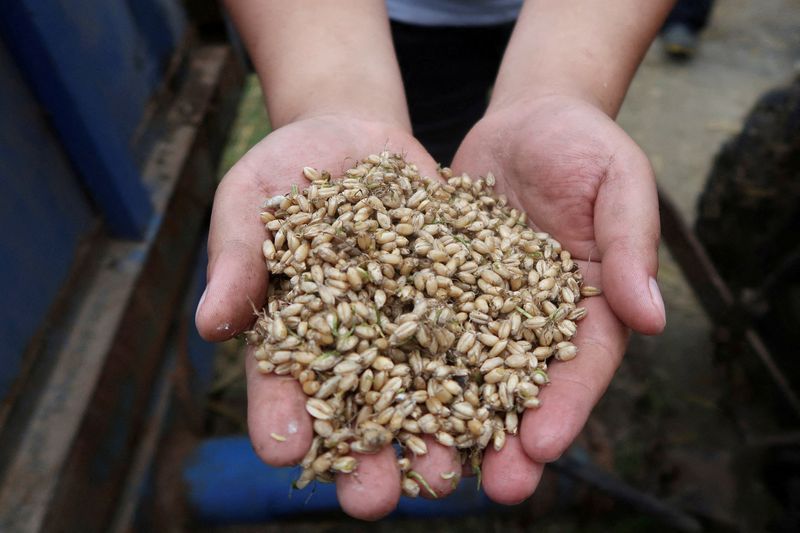By Naveen Thukral and Dominique Patton
SINGAPORE/BEIJING (Reuters) - China is set to import record volumes of wheat this year, trading sources say, with rain damage to its crop and worries over dry weather in exporting nations fuelling Beijing's appetite to buy while prices are low.
Traders said China's frantic buying is likely to support global prices, which have dropped more than a quarter this year - based on the Chicago futures benchmark price - amid abundant supplies from top exporter Russia.
The world's biggest wheat producer and consumer, China bought around two million metric tons of new-crop Australian wheat in October, for shipments starting in December, trading sources told Reuters. It has also booked about 2.5 million metric tons of French wheat since September, for December-March shipment, they said, noting these were unusually large volumes for this time of year.
Overall, China's 2023 imports are likely to reach around 12 million tons, two Singapore-based traders said, topping 2022's record 9.96 million tons, and the avid buying is expected to continue into 2024.
"China has had problems with crop quality this year and Australia, which is the main wheat supplier to China, is going to have a much smaller crop," said one of the Singapore traders, who is at an international company which sells wheat to China.
"They are buying as much as they can and as early as possible. Supplies are going to eventually tighten, especially from Australia," the trader said.
China has said its wheat crop shrank 0.9% this year to 134.5 million tons, the first decline in seven years despite expanded acreage, after heavy rain battered mature grain in the key central growing region just before the harvest.
Beijing has not provided a crop quality assessment.
However, according to estimates by the two Singapore traders and one dealer in Sydney, around 25 million tons or about 20% of China's harvest this year was damaged by rains. Some of that rain-damaged wheat will only be fit for animal feed or for blending with higher quality imported wheat before being milled into flour.
China's agriculture ministry did not immediately respond to a request for comment.
The world's biggest hog producer, China's Muyuan Foods has benefitted from the availability of rain damaged wheat. Muyuan told investors on Friday that purchases of germinated wheat, which occurs when mature plants get wet and can no longer be used for milling, contributed significantly to lowering production costs.
"Australia has the opportunity to fill the quality gap that China is currently suffering, particularly for high protein milling wheat," said Stefan Meyer, a grains broker at StoneX in Sydney.
While wheat output in Australia, the world's second largest exporter, is forecast to drop to 26 million metric tons, down from last season's record 39.7 million tons, due to dryness from the El Nino weather pattern, the quality is better this year as dry weather results in higher protein content.
Ma Wenfeng, senior analyst at Beijing Orient Agribusiness Consultancy, said a lower share of China's wheat harvest - about 20 million tons - was unsuitable for high-quality milling, although a portion of it can be used after cleaning.
Ma and others in China said attractive prices were a bigger driver of China's imports.
"Price is the main reason - it's really cheap," said Rosa Wang, analyst at Shanghai JC Intelligence Co Ltd, adding that
China was probably looking at the mounting weather risks in top exporting countries and "making preparations" for next year.
MORE TO COME
China's January-September wheat imports jumped 53.6% to 10.17 million metric tons, customs data showed, including 6.4 million tons from Australia and 1.8 million tons from Canada. Those figures don't reflect orders made for future delivery, such as recent purchases of U.S. soft red winter wheat.
Unlike other commodities, China's imports of Australian wheat were largely unaffected by the bilateral tensions between the two governments in recent years. Indeed, those tensions have eased in recent months.
Beijing's heavy buying from Australia could force rival importers such as Indonesia and Japan to seek alternatives from North America and the Black Sea region, traders said.
Chinese wheat purchases have stabilised global wheat prices, one of the Singapore traders said.
"But we expect prices to rise going forward, when China starts taking more volumes of higher quality wheat from the U.S. as Australian supplies are going to tighten," the trader said.

Given lower output in Australia, traders and analysts said China is likely to import significantly higher volumes of French wheat in the coming months.
"With the U.S. having a slightly larger spring wheat crop, a type of wheat that can very much act as an 'improver' supply for many importers, we would not be surprised to see China seek some U.S. and maybe Canadian Spring wheat," said Jeffrey McPike, a U.S. analyst with brokerage WASDEA Commodities.